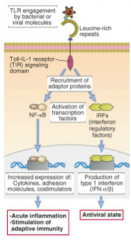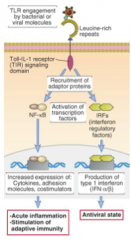![]()
![]()
![]()
Use LEFT and RIGHT arrow keys to navigate between flashcards;
Use UP and DOWN arrow keys to flip the card;
H to show hint;
A reads text to speech;
22 Cards in this Set
- Front
- Back
|
Name some cell types that have various PAMP receptors that bind directly to microbes.
|
"HEP"
Hepatocytes Epithelial Cells Phagocytic Cells |
|
|
Which plasma proteins bind directly to PAMPS?
|
C3, CRP, MBL, SAP
|
|
|
What are DAMPs?
|
Damage associated molecule patterns. Innate cells have receptors for DAMPs that bind to molecules released during tissue damage. They help macrophages manage the wound healing process.
|
|
|
What initiates PAMP receptor cascades? Use TLR's as an example.
|

Ligation of PAMP receptors initiate signal transduction cascades.
When TLR engages an extracellular pathogen, a TIR (Toll-IL-1receptor) signaling domain on the inside of the cell recruits "adaptor proteins," which activate transcription factors. |
|
|
What is NFkB's role in PAMP signal transduction cascades? What is the general result?
|

After initiation through a TLR, NFkB travels to the nucleus and causes increased expression of
"CAC": cytokines, adhesion molecules and costimulators It causes acute inflammation & stimulation of adaptive immunity. |
|
|
What is an IRF and what is its role in PAMP signal transduction cascades?
|

After initiation by a TLR, IRF's (Interferon regulatory factors) cause an increase in the production of type 1 interferon IFN-a/b leading to an antiviral state.
|
|
|
What are the two main type I interferon products of PAMP receptor signaling that help control intracellular infections?
|
Cytokines IFN-a & IFN-b
|
|
|
What cell types produce IFN alpha?
|
IMBED
IFN-alpha: macrophages, B-cells, epithelial cells, dendritic cells |
|
|
What cell type produces IFN beta?
|
fibroblasts
|
|
|
What cell types have receptors for type I interferons?
|
Almost all cells have receptors for type I interferons and therefore all cells can respond to these ligands.
|
|
|
What is the result of the signal transduction pathway activated by type 1 IFN/s?
|
Binding of either INF's activates signal transduction pathways that result in production of enzymes that:
1. inhibit protein synthesis 2. degrade viral mRNA (antiviral state) |
|
|
Is a Natural Killer cell (NK cell) a member of the innate or adaptive immune response?
|
Innate
|
|
|
What are the two methods through which activated NK cells control infections? How are they activated?
|
1. inducing apoptosis of infected cells through direct contact
2. Secreting cytokines like IFN-gamma that activate macrophages to phagocytose infected cells NK cells are activated by a variety of receptors, like INF type I receptors, PAMP, etc. |
|
|
If a pathogen is extracellular, how can the pathogen activate an inflammatory response (influx of leukocytes) into tissue?
|
It can bind to PAMP receptors on innate leukocytes residing within healthy tissues.
|
|
|
Where are mast cells found?
|
Mast cells (non-phagocytic) are resident cells in all CT.
They predominate in: "SHRIMPS" Submucosa/ lamina propria of GI tract Hypodermis Respiratory tract submucosa/lamina propria I-(invalid, just needed a vowel...) Mesentery Papillary layer of dermis Serous membranes in serous membranes, in mesentery, in the papillary layer of the dermis, in hypodermic. Think "raising the mast on a shrimp-ing boat" |
|
|
What activates mast cells?
|
"CODAS"
C3a, C4a, C5a binding ot complement receptors in plasma membrane Opiates that block neurokinin receptors that substance P binds to DAMPs and PAMPs binding to receptors Allergens binding to specific antibodies (IgE) already present on the mast cell surface Substance P pain neurotransmitter released by nociceptors) |
|
|
Name some chemicals mast cells release?
|
"PITCHS"
Prostaglantins and Leukotrienes IL-4 (a cytokine) Tryptase & other neutral proteases Cytokines (TNF & other cytokines) Histamine/Heparin Serotonin |
|
|
What are the three actions of Histamine?
|
1. smooth muscle contraction (bronchospasm/increased gut peristalsis)
2. neutrophil chemoattractant 3. local vasodilaiton |
|
|
How does Histamine cause vasodilation?
|
Activates NO production in endothelial cells which relaxes arteriole xmm and prevents platelets from attaching to endothelium. This allows blood flow to slow and pool (leading to redness and heat production). As a result endothelial cells are pushed apart and there is an increased capillary permeability, leading to swelling (plasma leaks into tissues).
|
|
|
What small role does serotonin play in the immune response?
|
It is released by mast cells and causes local vasodilation by activating NO production in endothelial cells and stimulating nociceptors and substance P release = pain.
|
|
|
What role does heparin play in mast cell immune response?
|
Heparin is released from mast cell granules upon activation and temporarily prevents fibrin from forming (thrombin is inactivated).
|
|
|
What are two functions of neutral proteases like tryptase in the mast cell immune response?
|
1. cleaves C3 to C3a which stimulates more mast cell degranulation
2. cleaves fibronectin and type IV collagen to degrade the basal lamina of capillary beds, leading to swelling and attraction of fibroblasts for wound healing/scar tissue formation and activation of coagulation cascades (blood clot formed to wall off infection). |

